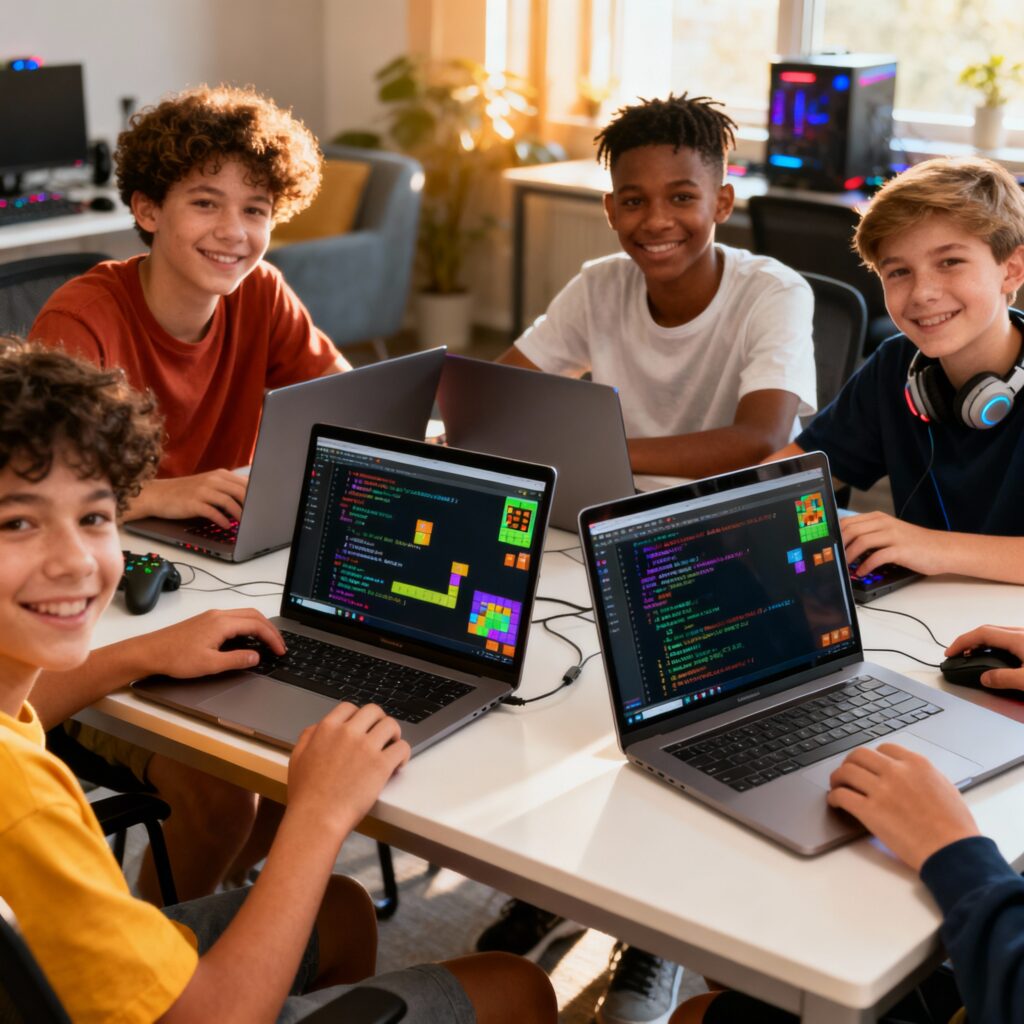Transform from player to creator with essential junior game development tips, coding basics, and playtesting strategies—complete with inclusive images and SEO-optimized content to inspire future developers and drive traffic!

Gameplay is fun, but building your own game? That’s legendary. This guide combines professional insights, humor, and SEO savvy to help junior gamers design, code, and launch their first game. Join our multicultural crew as they sketch storyboards, write code, and celebrate playtest successes—because everyone can be a game maker!
1. Why Create Your Own Game? Unleash Your Imagination
Game development empowers you to:
- Express Creativity: Craft unique worlds, characters, and stories.
- Learn Coding Skills: Gain valuable programming experience early.
- Understand Game Mechanics: Deepen your appreciation for favorite titles.
- Share with Community: Showcase creations on itch.io, game jams, or among friends.
Include junior game development tips and why kids should code in headings for SEO traction.
2. Planning & Storyboarding: Blueprint Your Vision
Solid planning ensures smoother development:

- Concept Ideation: Brainstorm game genre, theme, and core mechanics.
- Storyboards & Sketches: Draw character designs, level layouts, and UI mockups.
- Feature List: Prioritize must-have elements—player controls, scoring, win conditions.
- Timeline & Milestones: Set achievable deadlines for prototype, alpha, and beta stages.
Embed game planning guide and storyboarding tips for juniors for targeted SEO.
3. Choosing Your Tools: Engines & Languages
Pick beginner-friendly development platforms:
- Scratch: Block-based coding ideal for first projects.
- Godot: Open-source engine with visual scripting and GDScript (Python-like).
- Unity: Powerful engine using C#; many tutorials for beginners.
- Construct: Drag-and-drop interface for 2D games without coding.
Use best game engines for kids and junior programming tools to guide readers.
4. Basic Coding Concepts: From Variables to Loops
Understand essential programming building blocks:
- Variables: Store player scores, health points, or positions.
- Conditional Statements: Create game logic—if health ≤0 then game over.
- Loops: Repeat actions like enemy spawns or background animations.
- Functions & Events: Organize code into reusable blocks and respond to user input.
Include coding basics for junior gamers and learn game coding for SEO depth.
5. Building Your Prototype: Start Small, Test Often
Iterate quickly to refine mechanics:
- Minimal Viable Product (MVP): Focus on core gameplay without polish.
- Placeholder Assets: Use simple shapes and text before final art.
- Rapid Iteration: Implement one feature at a time and test immediately.
- Feedback Loops: Share prototypes with peers for early input.
Embed game prototyping tips and rapid iteration guide for practical SEO.
6. Art & Sound Assets: Bringing Worlds to Life
Visuals and audio enhance immersion:
- Free Asset Libraries: Use sites like OpenGameArt or Kenney.nl for sprites and sounds.
- Basic Pixel Art: Learn to draw characters and tiles in Aseprite or Piskel.
- Sound Effects & Music: Create royalty-free audio with tools like Bfxr or Soundtrap.
- Consistent Style: Maintain uniform color palettes and art styles for cohesion.
Include game art tips for kids and junior sound design for SEO relevance.
7. Playtesting & Debugging: Polish Your Gameplay
Thorough testing ensures fun and stability:

- Test Case Creation: List scenarios—win, loss, edge cases like zero lives.
- Bug Logging: Record issues with screenshots or descriptions for efficient fixing.
- Peer Playtests: Invite friends to play and note their feedback.
- Iterative Debugging: Focus on one bug at a time; verify fixes immediately.
Target game testing strategies and junior debugging tips for SEO impact.
8. User Interface & Experience (UI/UX): Make It Intuitive
Ensure players understand and enjoy your game:
- Clear Menus: Label buttons like “Start,” “Instructions,” and “Exit” plainly.
- HUD Design: Display health, score, and timers in non-intrusive spots.
- Feedback Effects: Use animations and sounds for actions—like button clicks or damage.
- Accessibility Options: Include adjustable text sizes and colorblind-friendly palettes.
Embed junior UI tips and game UX basics for inclusive SEO.
9. Publishing Your Game: Share with the World
Launch your creation on platforms:
- itch.io: Free hosting with customizable game pages.
- Itch Game Jams: Participate in themed jams to gain visibility and practice deadlines.
- School & Community Showcases: Present at local events or coding clubs.
- Simple Web Builds: Export HTML5 games for instant browser play.
Include how to publish games and junior game launch tips for actionable SEO.
10. Monetization & Feedback: Grow as a Developer
Learn from and possibly profit off your work:
- Optional Donations: Enable pay-what-you-want on itch.io.
- Premium Upgrades: Offer bonus levels or cosmetic packs for a fee.
- Community Feedback: Encourage reviews, bug reports, and feature requests.
- Analytics Tracking: Use simple metrics—play counts, completion rates—to guide updates.
Use game monetization basics and gather player feedback for developer-focused SEO.
11. Continuous Learning: Resources & Communities
Expand your skills with supportive networks:
- Online Tutorials: Follow YouTube channels like Brackeys (Unity) or HeartBeast (Godot).
- Coding Clubs: Join after-school or online communities like Code.org or CS First.
- Documentation & Forums: Reference official docs and ask questions on Stack Overflow or Reddit.
- Game Jams & Hackathons: Challenge yourself in time-bound events for rapid growth.
Embed game dev resources for kids and junior developer communities for SEO visibility.
12. SEO & Content Strategy: Rank Your Dev Guide
Optimize your blog for aspiring creators:
- Keyword Placement: Use junior game development, learn to code games, create your first game in titles and headers.
- Step-by-Step Lists: Code tutorials benefit from numbered sequences.
- Internal Links: Connect to posts on coding, art, and community-building.
- Descriptive Alt Text: “diverse juniors coding in Godot engine” for images.
13. Celebrating Your Creation: Host a Launch Party
Share the joy of your first game release:
- Live Streams: Play and comment on your game live for friends and family.
- Beta Events: Invite a select group to trial your game and provide feedback.
- Prize Giveaways: Offer small digital badges or certificates for top testers.
- Showcase Videos: Create a trailer or dev diary highlighting development journey.
Your Game Awaits Its Heroes!
Armed with planning, coding basics, and publishing know-how, you’re ready to step from gamer to game maker in 2025. Bookmark this #30 guide, gather your team, and let’s build worlds—together!


Leave a Reply